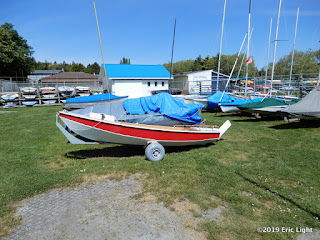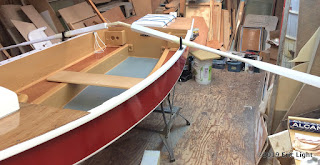A Better Camp Cruiser
Although I like the Mixer2 design as it is, I do find it quite tender. So I thought I'd draw up something similar that would have many of the same characteristics as the Mixer2, but be more stable and possibly able to plane.
Although I like the Mixer2 design as it is, I do find it quite tender. So I thought I'd draw up something similar that would have many of the same characteristics as the Mixer2, but be more stable and possibly able to plane.
I wanted to go in the direction of the Goat Island Skiff, only not so big, and not flat-bottom all the way. The beauty of the bilge plank is that it allows a Vee entry at the bow. So what I did was to keep just a bit of that bilge plank amidships, and widen it a lot at the bow, a little at the stern.
I widened the bottom plank aft and straightened out the run a bit as well, so given the right conditions (lots of wind) it might plane. At any rate, it'll be much less tender, and could probably take a small motor off the transom. The sides are a bit higher off the water, so it won't be great to row, but the point is to sail as much as possible.
As drawn, this design (which I'm tentatively calling "Knucklebutt" because of that little knuckle at the bottom amidships) is 13' long by 44" wide plus rub rail, so about 4' wide. It could stand to have a bit more sail area than the Mixer2's largest sail plan, which I think was 68 sq ft—so maybe 75 sq ft.
The pink lines are metric measurements that I used to scale the plan to model size. A model is in progress.
Deck plan and cockpit layout:
Below are the station plans with measurements, so one could build a boat from them, or put them into a hulls app to get panel shapes from. I don't have a hulls app going at the moment (it needs to run in a Windows machine), so I'm using a drawing app on my Mac, thus cannot expand the panels to find their true shapes.
 |
| Cockpit is 7' long |
Station 0.75, 9" from the bow, is where the flat bottom starts:
Etcetera...
Barring some miracle, I won't have a shop to build this in, so if anyone builds from this plan it would be nice to hear how it goes. If you want to dialogue, put your email address in a comment. I moderate the comments, and wouldn't make yours public without your permission, if it has your email in it.




















































